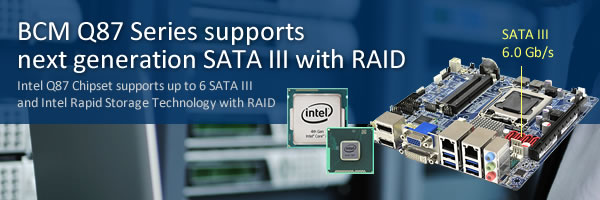

|
BCM’s Haswell Q87 Series motherboards support RAID 0/1/5/10 with Intel® Rapid Storage Technology ideal for server applications or Intelligent systems that require performance intensive data transactions
In June this year, BCM introduced three Haswell Q87 series based industrial motherboards (IMB) spanning the top IMB form factors including BC87Q (ATX), RX87Q (uATX) and MX87QD (Mini ITX). Each motherboard is equipped with enterprise desktop Intel® Q87 chipset and LGA1150 socket supporting 4th generation Intel® Core™ i7, i5 and i3 processors. The motherboards are also equipped with multiple high-speed SATA III storage interfaces offering up to 6 Gb/s transfer rate to support next-generation SSD and traditional HDDs. With RAID functionality natively supported by the Intel® Q87 chipset and driven by Intel® Rapid Storage Technology, these motherboards are able to support RAID level 0, 1, 5 and 10 which not only optimizes data transferring performance but also provide failsafe backup protections against disk failure making these motherboards ideal for server applications or any intelligent computing system that handles massive data transactions in 24/7 non-stop operating environments such as transaction processing or data centers and hospital imaging systems.
What's RAID? What's the difference between RAID 0, 1, 5 and 10
RAID stands for Redundant Array of Independent Disks. This technology uses an array of HDD for either better performance or better security against disk failure. The RAID functions give us varying total hard drive capacities and options of backing up/synchronizing data. Using 80Gb SSD/HDD as an example with different levels of RAID functions:
RAID 0 - Stripping
Using two 80GB HDD with RAID 0 function as an example, total 160GB storage space is provided. All data is split between the two HDD. It helps increase the data transferring performance however it does not backup the data on any of these drives.
RAID 1 - Mirroring
Using two 80GB HDD with RAID 1 function, only 80GB storage space is available because both HDD synchronize the same data which is ideally used for protecting important data if one of the HDD fails. This option does not speed-up the performance.
RAID 5 Stripping + Parity
RAID 5 requires at least three HDD. With RAID 5 function, data is striped as RAID 0 for speed and parity is distributed along with data for good redundancy as RAID 1 to protect your data from a single drive failure. It is most commonly used RAID function because it creates balances between faster performance, added data protection and cost effective in terms of less HDD are required comparing to RAID 10 which requires four HDD.
RAID 10 Striping + Mirroring
Using four 80GB HDD as an example, RAID 10 is also referred to as RAID 1 + 0, it is a combination of RAID 0 and 1 therefore two stripped drives will be included in logical drive space (160GB) while the mirrored drives will appear invisible. This option benefits both performance and data protection; however it is usually more costly than RAID 5 because of additional HDD needed.
BCM Motherboards with RAID support:
Availability
For BCM distribution channels, please contact your Regional Sales Manager to request an evaluation sample. For other, please email your inquiry to BCMSales@bcmcom.com. * All product specifications and product images are subject to change without notice.
|
|
|
© BCM Advanced Research, 11 Chrysler, Irvine, California, USA.. All Rights Reserved.
BCM Advanced Research (BCM) is a leading developer and manufacturer of x86/ARM RISC embedded industrial motherboards and systems for ODMs and OEM that integrate computing technology into their products. We own a very strong R&D engineering team and operation department based in Southern California in order to provide prompt project develop support and instant problem solving assistance.
We can be reached by email BCMSales@bcmcom.com. To unsubscribe from this e-mail list, reply to this e-mail with "unsubscribe" in the subject line or Click here to unsubscribe. |
|
|